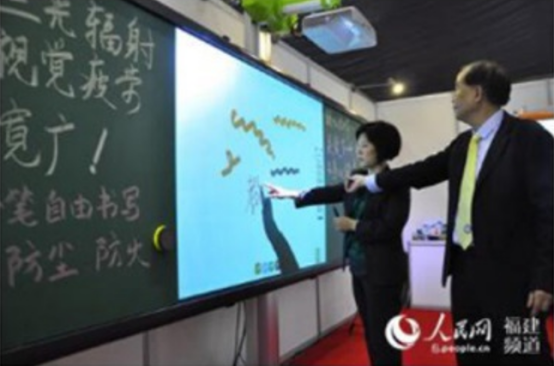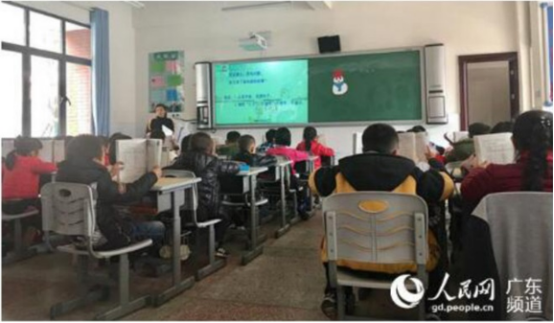People's Daily: Don't let the next generation spend their lives with glasses
People's Daily Political article 2018-08-03

The myopia rate of children and adolescents in China ranks first in the world, the myopia rate of high school students and college students has exceeded 70%, and the myopia rate of primary school students is close to 40%, and it is increasing year by year. "Shining mirror" has become a common scene in various primary and secondary schools, so that parents, schools, education departments hurt the brain.

"Everything is a Mosaic, the scenery is hazy beauty", "twenty meters away from humans and animals, thirty meters away six relatives do not recognize." These are the self-deprecating jokes of the nearsighted, but when it comes to the state of the eyesight of the bear children, there are more than a few simple jokes...
Recently, the Ministry of Education and the National Health Commission jointly drafted the Implementation Plan for Comprehensive Prevention and Control of Myopia in Children and Adolescents (Draft for comments) (hereinafter referred to as the "Plan"), in order to comprehensively prevent and control myopia in children and adolescents, we are ready to fully listen to the opinions and suggestions of all sectors of society on the prevention and control of myopia in children and adolescents.

The prevention and control of myopia among teenagers is to be included in the government assessment index
The reason why this program has attracted attention is that in addition to the general concern of all sectors of society about the situation of myopia in teenagers, it is also that the program clearly proposes to include the prevention and control of myopia in teenagers into the government assessment index.
The plan requires that The State Council sign a responsibility letter with the provincial people's governments to comprehensively strengthen the prevention and control of myopia in children and adolescents, and local people's governments at all levels sign a responsibility letter step by step, and hold local governments and schools accountable according to law and regulations for the decline in the physical health level of children and adolescents for three consecutive years.
A national evaluation and assessment system for the prevention and control of myopia among children and adolescents has been established. Based on the verification of the myopia rate among children and adolescents in 2018 by the National Health Commission and the Ministry of Education, the evaluation and assessment of the prevention and control of myopia among children and adolescents by the people's governments of all provinces (autonomous regions and municipalities) has been carried out annually since 2019, and the results have been released to the public.
The number of nearsighted people in the country is nearly half, have you?
How serious is myopia of Chinese youth?
According to a 2017 research report by the World Health Organization, the number of myopia patients in China is as high as 600 million, almost half of the country's total population. Among them, the myopia rate of children and adolescents in China ranks first in the world, the myopia rate of high school students and college students has exceeded 70%, and the myopia rate of primary school students is close to 40%, and it is increasing year by year.
"Shining mirror" has become a common scene in various primary and secondary schools, so that parents, schools, education departments hurt the brain.
Target: By 2030, the myopia rate of primary school students will be reduced to less than 38%
In view of the high and rising myopia rate of children and adolescents in China, the plan puts forward clear prevention and control goals:
By 2023, we will strive to reduce the overall myopia rate of children and adolescents in the country by more than 0.5 percentage points per year on the basis of 2018, and provinces with high myopia incidence will reduce by more than 1 percentage point per year.
By 2030, the rate of new myopia among children and adolescents nationwide should be significantly reduced, and the overall level of visual health of children and adolescents should be significantly improved. The rate of myopia among 6-year-olds should be controlled to about 3%, among primary school students to less than 38%, among middle school students to less than 60%, and among high school students to less than 70%.
Today, with the increasing popularity of electronic products, the increasing burden of primary and secondary school students in and out of class, and the lack of time for outdoor activities, it seems not easy to achieve this goal, which can be described as "the prevention and control goal has not been reached, and all parties still need to work together."
Tighter regulation, with schools and health facilities taking responsibility
Primary and secondary students spend most of their time in school, and the programme therefore places a number of requirements on schools and health facilities, as follows:
In terms of school:
First, we will reduce students' academic burden. Primary and second grades do not have written homework, grades three to six written homework completion time should not exceed 60 minutes, junior high school should not exceed 90 minutes, in principle, paper homework.
Second, strengthen examination management. Strictly control the number of in-school examinations during the compulsory education stage, and the first and second grades of primary schools shall not exceed once per semester, and the other grades shall not exceed twice per semester. It is strictly forbidden to publish students' exam results and rankings in any form; It is strictly prohibited to use the award certificate of various competitions, the results of discipline competitions or grade certificates as the basis for enrollment; It is strictly prohibited to organize examinations in various names to select students.
Third, improve the visual environment. School classroom lighting hygiene standards up to 100%. According to the lighting conditions of the classroom and the changes in students' eyesight, students' seats are adjusted once a month, and the height of students' desks and chairs are personalized adjusted every semester to adapt to the changes in students' growth and development. We will accelerate efforts to eliminate the phenomenon of large class sizes.
Fourth, adhere to eye health exercises and other eye care measures. Primary and secondary schools should strictly organize all students to do eye health exercises every day in the afternoon, and carefully implement the eye health exercise process. Teachers should urge students to sit upright when reading and writing, supervise and correct students' bad reading and writing posture at any time, and remind students to comply with the requirements of "one foot, one punch, one inch".
Fifth, strengthen outdoor physical exercise. Ensure that primary and secondary school students have at least one hour of physical activity per day. Strictly implement the national curriculum standards for physical education and health, ensuring that primary and second grades have four class hours per week, grades three to six and middle schools have three class hours per week, and high schools have two class hours per week. Primary and secondary schools arrange 30 minutes of sports activities between classes every day. We will fully implement the sports homework system for students in winter and summer vacations, and urge students to check their completion.
Sixth, the rational use of electronic products. Guide students to use electronic products in a scientific and standardized way, and develop good habits of learning and eye health under the information environment. Control the use of electronic products to carry out teaching time, in principle should not exceed 30% of the total teaching time.
The seventh is to carry out regular vision monitoring. Primary schools should receive electronic visual health records of children and adolescents transferred from medical and health institutions to ensure that one person has one file and is transferred in real time with the change of school status. Strictly implement the health examination system for students and the vision monitoring system twice per semester, give warning education to students with abnormal vision, issue personal exercise prescriptions and health care prescriptions for them, timely inform parents to take students to eye medical institutions for examination, do a good job in the detection rate of poor vision, new incidence of report and statistical analysis, and cooperate with medical and health institutions to carry out vision screening. Schools and medical and health institutions should timely record the results of vision monitoring and screening into the electronic visual health records of children and adolescents.
Eighth, strengthen vision health management. Establish a vision health management team that integrates student representatives such as school leaders, class teachers, school doctors (health teachers), student vision protection committee members and volunteers, with clear and detailed responsibilities. Integrate myopia prevention and control knowledge into classroom teaching, students' daily behavior norms and campus culture. Strengthen the strength of medical offices (health rooms, school hospitals, health care rooms, etc.), and equip school doctors and necessary medical equipment according to standards.
Ninth, it is forbidden to "elementary school" kindergartens. Strictly implement the learning and development guidelines for children aged 3-6, attach importance to the value of life and games for the growth of children aged 3-6, and prohibit "elementary school" teaching. To ensure that children have more than 2 hours of outdoor activities every day, boarding kindergartens shall not be less than 3 hours, combined with the characteristics of the region, season and school age stage, to provide children with nutritious meals that are beneficial to vision health and promote vision protection.
Health care facilities:
One is to create a vision profile. Since 2019, the annual coverage of eye care and vision examinations for children aged 0-6 years has exceeded 90%. On the basis of examination, electronic visual health records of children and adolescents are established and updated in time by relying on existing resources, and transferred in real time with children and adolescents entering school.
Second, standardized diagnosis and treatment. General hospitals at and above the county level generally provide ophthalmic medical services. For children and adolescents with high myopia or pathological myopia, the harm of the disease should be fully informed, reminding them to take preventive measures to avoid the occurrence of complications or reduce the harm of complications. Develop follow-up interventions, and record the examination and correction information in the electronic record of children and adolescents vision health in a timely manner. Give full play to the role of traditional Chinese medicine in the prevention and treatment of myopia in children and adolescents, formulate and implement integrated treatment programs of traditional Chinese medicine and Western medicine, and promote the application of traditional Chinese medicine characteristic techniques and methods.
Third, we will strengthen health education. In view of people's lack of myopia prevention and treatment knowledge and lack of awareness of the seriousness of myopia harm to health, we should give full play to the guiding role of experts in ophthalmology, optometry, disease prevention and control, and traditional Chinese medicine, take the initiative to enter schools, communities, and families, and actively promote the popularization of vision health science knowledge to prevent children and adolescents from myopia. We will strengthen nutrition and health publicity and education, and provide nutrition and health guidance and services in light of local conditions. We will promote the development of healthy cities.
Finally, the child's visual health can not be separated from the careful care of parents. Usually to help children develop healthy habits, especially with the eye habit, to achieve early detection and early intervention. I hope that the whole society will work together to stop our next generation from living with glasses!
People's Daily Politics and Culture Department exclusive original
Editor: Feng Xuezhi and Zou Wenxue